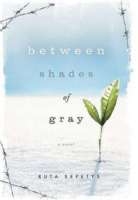Monique Storie, University of Guam, Latte Heights, GU

. . . I am beginning to understand what our teachers were trying to get us to appreciate when we doing literary analyses in high school. . . Why did their efforts make it seem like a reader could only enjoy the story by examining its literary elements?
This summer, I had the luxury of engaging in literature explorations with others who are enthusiastic about children’s literature. One of the novels we shared, Between Shades of Gray (Sepetys, 2012), shocked me into thinking about the intricacies of Rosenblatt’s stances to reading. In the workshop, our literature discussions began with an initial sharing of our thoughts on the book. When Mary shared that she had not foreseen what happened to the mother, I countered that it had to happen so that Lina could change. We then ventured off into a discussion on the story’s structure and how certain events logically had to lead to other events in order for the story to move forward.
This exchange resulted in us thinking about how we approached this story, or any story for that matter. Mary declared herself a “Pollyanna” reader, alluding to the protagonist in Eleanor Porter’s 1913 novel who looks for the good in every situation. Her identification was based on the idea that she approaches a reading experience hoping for a happy ending. I decided that I was more of an “Encyclopedia Brown”, the boy detective of Donald Sobol’s mystery series of the same name, because my mind tends to search for the logical path of what will happen next.
I left that discussion thinking that we represented different spots on Rosenblatt’s aesthetic-efferent stance continuum with Mary placed firmly in the aesthetic while I was more towards the efferent (Rosenblatt, 1978). In Mary’s Pollyanna approach, an individual goes into the reading experience hoping for a good read. In my Encyclopedia Brown position, the person’s reading experience (and appreciation of the story) is influenced by the clues he or she finds that points to how the story will progress and how it will end.
As I thought about it more, I realized that it is not such a clear cut assessment. In some ways, I agree with my initial thought because I have had fully aesthetic experiences and they are markedly different from the way I usually read. For example, I so thoroughly enjoyed the Harry Potter series that by the time Harry Potter and the Deathly Hallows came out, I purposely did not read the final chapters for months because I could not bear to find out who died nor did I want the adventure to end.
In contrast, my usual stance is a layered experience in which part of my mind is living through the story but the other part is clicking methodically away through questions about its construction, such as “where does the author go with the plot?” or “what will need to happen next in order for the story to have a satisfying ending?” These questions appear to sit within the realm of the efferent because I’m subconsciously analyzing the plot or character development to see how the author constructed the story. But, for me, it is an aesthetic experience because I am enjoying the logistics of story’s construction. Basically, one part of my mind is enjoying a “lived through experience” constructed by the story and another part is enjoying a “poem” constructed of literary elements and my understanding of them. The easiest way I can explain it is that this experience is similar to the way one painter enjoys another’s artwork or the way a cook experiences another chef’s creation. They enjoy the sensory experience of the work because it engages their emotions but they also enjoy the artfulness of the work because they understand mechanics of their craft enough to be able to see and appreciate the skills another artist needs in order to construct the work.
In these realizations, I am beginning to understand what our teachers were trying to get us to appreciate when we doing literary analyses in high school. Now, I wonder why did their efforts make it seem like a reader could only enjoy the story by examining its literary elements? Why did I not get that it could be simultaneous and symbiotic experiences where one feeds into the other?
References
Porter, Eleanor. (1913, 2007). Pollyanna. Peru, IL: Cricket House Books.
Rosenblatt, Louise. (1978). The Reader, the Text and the Poem. Carbondale, IL: Southern Illinois Press.
Rowling, J.K. (2009). Harry Potter and the Deathly Hallows. NY: Arthur A. Levine.
Sepetys, Ruta. (2012). Between Shades of Gray. NY: Speak.
Sobol, Donald. (2007). Encyclopedia Brown. NY: Puffin.
Journey through Worlds of Words during our open reading hours: Monday-Friday, 9 a.m. to 5 p.m. and Saturday, 9 a.m. to 1 p.m. To view our complete offerings of WOW Currents, please visit archival stream.
- Themes: Monique Storie
- Descriptors: Debates & Trends, WOW Currents
